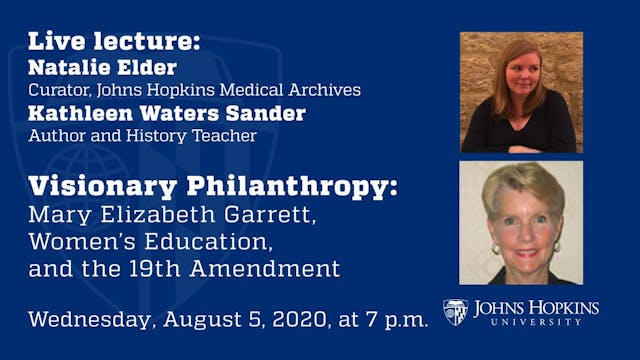Lunch with the Libraries & Musuems: Leave No Trace: JWG's Trip to the US West
Arts & Humanities
•
54m
Presented by Michelle Fitzgerald, Curator of Collections at the Johns Hopkins University Museums
When Evergreen resident John Work Garrett made his first trip to Yellowstone National Park in 1894 as the student ornithologist participating in one of the late-19th century Princeton Geological Expeditions, he would have been one of the earliest white tourists to enter the nation’s first national park. For the future diplomat, the trip was only the start in a lifetime of love for the American outdoors. He made sure to remember the trip through preserving his journals and photographs taken on the trip which offer a rare, personal glimpse into the outdoor recreational experience of late 19th century Americans.
Through looking at Garrett’s photographs and souvenirs, “Leave No Trace: John Work Garrett’s Trip to the American West” will travel with Garrett to gain a better understanding of the historic and present-day relationship that Americans have to the outdoors.
For more information on the exhibition "Leave No Trace", on view at the Evergreen Museum from September 25, 2024 to June 8, 2025, please visit https://museums.jhu.edu/exhibitions/current/leave-no-trace-john-work-garrett-in-the-american-outdoors/
#hopkinsathome #johnshopkinsuniversity #yellowstone #history #lunchwiththelibraries #lunchwiththelibrariesandmuseums #sheridanlibraries #jhu #johnworkgarrett
00:00 - Welcome / Intro to Exhibit and Presentation with Michelle Fitzgerald
02:31 - Who was John Work Garrett?
04:34 - The history of outdoor recreation in the United States
05:16 - JWG and the Princeton Geological Expeditions
12:33 - Outdoor Tourism in America in the late 19th Century
13:04 - John Muir’s Influence on American Outdoor Tourism
14:03 - (In)Accessibility to Outdoor Tourism and Travel
14:56 - Economy and Market Capitalism of Outdoor Recreation Goods
16:47 - Women in the world of outdoor adventure
17:20 - Western Saddle v Side Saddle
18:43 - JWG his findings and his takings; hunting and taxidermy
20:20 - The American Bison - The Fall and the Rally
22:52 - Souvenirs, “Discoveries”, and their display/role
25:03 - Native Goods and The “Indian Craze”
28:39 - Perception, Authenticity, and Worth of Native Goods
31:40 - Presentation, display, and framing of private collections of Native Art in a Modern World
33:29 - Accessibility to travel and National Parks in this era
34:22 - Race and Wealth Restrictions to Parks Access
36:35 - Consumer Market for Outdoor Recreation Goods
38:06 - Keystone Species and the Environment
39:00 - JWG’s National Parks compared to Today’s National Parks
40:48 - Leave No Trace principles
41:43 - Closing Thoughts on JWG and his impact on outdoor trends
42:10 - “I have never seen a prettier place[…]”
43:09 - Presentation Concludes, Info Re: Upcoming JWG Exhibit AT Evergreen
43:30 - Transition to Q+A - Michelle Intro
43:53 - “What artifacts are available to look at, in Evergreen?”
44:44 - “How did they preserve the eggs? “Do they need special techniques
to preserve them?”
45:48 - “What parallels do you see between Garrett's journey and nature travel today? Aside from visitor numbers
and improved gear, do you think things are more similar than different?”
47:26 - “Did other members of the Garrett family also travel and explore nature, either predecessors or ancestors?”
50:28 - “I have a question related to archival research and materials. What type of records did you use to discover these details, in addition
to John Work Garrett's journal?”
52:41 - “Are there any events scheduled to view the exhibition?”
53:51 - Goodbye, Thank You, How to reach Michelle for more questions.
Up Next in Arts & Humanities
-
Visionary Philanthropy
In this conversation between author Kathleen Waters Sander and curator Natalie Elder, they will explore the role that Baltimore’s Gilded Age philanthropist Mary Elizabeth Garrett played in the fight to pass the 19th amendment. Garrett’s suffrage activism revived the fight in Baltimore in the earl...
-
Session 3: Music and Technology in th...
Thomas Dolby - the Homewood Professor of the Arts and head of the Peabody Conservatory’s Music for New Media program - answers the question: "Why use music in films?" in this detailed explanation of the history and conventions of musical scoring for films and TV, with a look into the future of in...
-
Session 2: Music and Technology in th...
For musicians hoping to get experience in a professional recording studio, or those wanting to hone their home recording chops—or just music fans!—here is a primer on how a recording session is conducted, how to prepare and rehearse for it, and the roles of the musicians, producer and sound engin...



